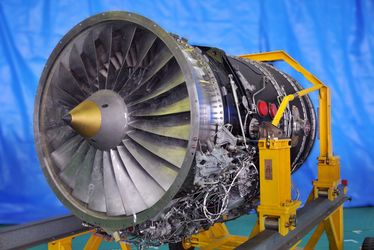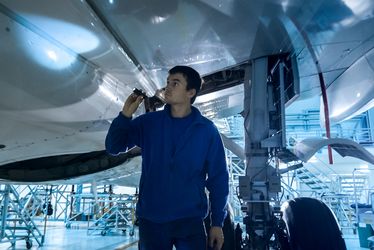Aerospace – Test & Development
In the aerospace industry, components made of lightweight and high-strength components must meet strict design and quality requirements. In order to increase safety while reducing fuel consumption, developers and test engineers need efficient and precise measurement technology. Optomet laser Doppler vibrometers perform reliable non-contact measurements without influence on the object and without the need to attach sensors, even under challenging test conditions.
Turbine Blades – Safety, Durability & Efficiency
Turbine jet engines have become an indispensable part of aircraft in modern aviation. Further developments are always aimed at improving flight safety, turbine efficiency, overall operating behaviour and reducing noise emissions.
One of the most important components of the turbine jet engine is the single turbine blade. The characteristics of a turbine blade under different load levels and at different temperatures influences the overall engine behaviour.
One way to better estimate the fatigue life of a blade is the “low cycle fatigue” (LCF) measurement method, in which the turbine is examined before and after repeated cyclic loads. The fatigue due to thermal load is examined in more detail using “Thermomechanical Fatigue” (TMF) methods at temperatures of up to 1000°C. Model calculations of the blade geometry serve to optimize damping properties and flow behaviour, as well as to suppress unwanted resonances.
Optomet laser Doppler vibrometers offer a reliable way of precisely measuring the operating vibrations of the blades before, after and during loading and heating phases using a non-contact method. Knowledge of the vibration properties allows the determination of modal parameters and the validation of model predictions. The change in properties under different loading methods allows users to predict the expected lifetime of the turbine under real operating conditions. The results are therefore important for determining the maintenance cycles of turbines and estimating the possible lifetime of turbines under overload, for example if the remaining turbine has to be operated well above normal load to compensate for the failure of another aircraft engine.
Scanning laser vibrometer systems provide particular added value for this method, since they enable quick and easy characterization of the operating vibration shapes on the blade surface.
Due to high signal strength and signal quality of Optomet laser Doppler vibrometers, special treatment or preparation of measurement surfaces is no longer necessary. Vibration parameters can be measured precisely even on glowing and poorly reflecting objects.

Loose Rivet Detection
With the steady increase in air traffic, the need for fast and reliable inspection methods that check the integrity of the material connections increases. Even though glued connections are becoming increasingly popular, riveted connections still make up the majority of connections in aircraft. Today’s standard inspection regulations require rivets to be visually inspected by certified personnel. These inspections are time consuming, prone to errors, and early stages of errors are usually not recognized.
Therefore, there is great interest in modern approaches that enable reliable and standardized inspection of riveted joints and at the same time shortening the downtime of planes.
Optomet scanning laser Doppler vibrometers (SLDV) enable non-contact, reliable and, above all, objective early detection of loose rivets. If the corresponding aircraft part, which is connected to rivets, gets excited in a broad frequency band, SLDVs can record and analyze the complete vibration behavior of its surface within the analysed frequency spectrum. Mapping the areas to be inspected around the rivet connections with suitable evaluations provides meaningful information on the condition of the rivets, such as the mean amplitude of the vibrations, the coherence distribution of the measurement data or the frequency transfer functions between different points on the surface.
A significant deviation of these quantities at closely localized positions compared to the rest of the surface allows a direct assessment of whether there is a tired riveted joint at these points, even if the riveted joint is not even visually recognizable. The extent of the deviation also allows a statement on the degree of fatigue of the rivet connection and thus also a decision as to whether this rivet should be replaced immediately or if the connection still has sufficient strength for further operation and an exchange can be carried out within a regularly planned maintenance schedule.

Aircraft Wing
During flight operations at high speeds, the wings of an aircraft are exposed to considerable vibration and deformation. Deformations can occur in a range between a few and a few hundred millimeters, whereas vibrations can range from nanometers to up to several hundred micrometers.
No conventional measuring instrument is able to cover such a measuring range of more than 160 dB in a single measurement. With the Optomet Nova Sense in connection with OptoGUI software, it is possible for the first time to measure the deformations and vibrations at the same time with a dynamic range of more than 220 dB. The superior performance of the Optomet Nova Sense has been confirmed by measurements on airfoil models in the wind tunnel.
